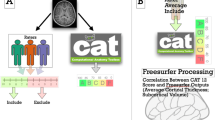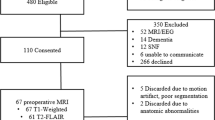Abstract
Quality assurance (QA) is vital for ensuring the integrity of processed neuroimaging data for use in clinical neurosciences research. Manual QA (visual inspection) of processed brains for cortical surface reconstruction errors is resource-intensive, particularly with large datasets. Several semi-automated QA tools use quantitative detection of subjects for editing based on outlier brain regions. There were two project goals: (1) evaluate the assumption that statistical outliers are related to errors of cortical extension, and (2) examine whether error identification and correction significantly impacts estimation of cortical parameters and established brain-behavior relationships. T1 MPRAGE images (N = 530) of healthy adults were obtained from the NKI-Rockland Sample and reconstructed using Freesurfer 5.3. Visual inspection of T1 images was conducted for: (1) participants (n = 110) with outlier values (z scores ±3 SD) for subcortical and cortical segmentation volumes (outlier group), and (2) a random sample of remaining participants (n = 110) with segmentation values that did not meet the outlier criterion (non-outlier group). The outlier group had 21% more participants with visual inspection-identified errors than participants in the non-outlier group, with a medium effect size (Φ = 0.22). Nevertheless, a considerable portion of images with errors of cortical extension were found in the non-outlier group (41%). Although nine brain regions significantly changed size from pre- to post-editing (with effect sizes ranging from 0.26 to 0.59), editing did not substantially change the correlations of neurocognitive tasks and brain volumes (ps > 0.05). Statistically-based QA, although less resource intensive, is not accurate enough to supplant visual inspection. We discuss practical implications of our findings to guide resource allocation decisions for image processing.


Similar content being viewed by others
References
Ahmed, B., Brodley, C. E., Blackmon, K. E., Kuzniecky, R., Barash, G., Carlson, C., & Thesen, T. (2015). Cortical feature analysis and machine learning improves detection of “MRI-negative” focal cortical dysplasia. Epilepsy & Behavior, 48, 21–28.
Bremner, J. D., Vythilingam, M., Vermetten, E., Vaccarino, V., & Charney, D. S. (2004). Deficits in hippocampal and anterior cingulate functioning during verbal declarative memory encoding in midlife major depression. American Journal of Psychiatry, 161(4), 637–645.
Chen, X., Liang, S., Pu, W., Song, Y., Mwansisya, T. E., Yang, Q., & Xue, Z. (2015). Reduced cortical thickness in right Heschl’s gyrus associated with auditory verbal hallucinations severity in first-episode schizophrenia. BMC Psychiatry, 15(1), 152.
Cohen, J. (1988). Statistical power analysis for the behavioral sciences. Hilsdale (p. 2). NJ: Lawrence Earlbaum Associates.
Collins, D. L. (1994). 3D Model-based segmentation of individual brain structures from magnetic resonance imaging data (Doctoral dissertation, McGill University).
Delis, D. C., Kaplan, E., & Kramer, J. H. (2001). Delis-Kaplan executive function system (D-KEFS). Psychological Corporation.
Desikan, R. S., Segonne, F., Fischl, B., Quinn, B. T., Dickerson, B. C., Blacker, D., Buckner, R. L., Dale, A. M., Maguire, R. P., & Hyman, B. T. (2006). An automated labeling system for subdividing the human cerebral cortex on MRI scans into gyral based regions of interest. NeuroImage, 31(3), 968–980.
Fischl, B., Salat, D. H., Busa, E., Albert, M., Dieterich, M., Haselgrove, C., van der Kouwe, A., Killiany, R., Kennedy, D., Klaveness, S., Montillo, A., Makris, N., Rosen, B., & Dale, A. M. (2002). Whole brain segmentation: Automated labeling of neuroanatomical structures in the human brain. Neuron, 33(3), 341–355.
Fischl, B., van der Kouwe, A., Destrieux, C., Halgren, E., Segonne, F., Salat, D. H., Busa, E., Seidman, L. J., Goldstein, J., Kennedy, D., Caviness, V., Makris, N., Rosen, B., & Dale, A. M. (2004). Automatically parcellating the human cerebral cortex. Cerebral Cortex, 14(1), 11–22.
Gur, R. C., Richard, J., Hughett, P., Calkins, M. E., Macy, L., Bilker, W. B., & Gur, R. E. (2010). A cognitive neuroscience-based computerized battery for efficient measurement of individual differences: Standardization and initial construct validation. Journal of Neuroscience Methods, 187(2), 254–262.
Kaufmann, L. K., Baur, V., Hänggi, J., Jäncke, L., Piccirelli, M., Kollias, S., & Milos, G. (2017). Fornix under water? Ventricular enlargement biases Forniceal diffusion magnetic resonance imaging indices in anorexia nervosa. Biological Psychiatry: Cognitive Neuroscience and Neuroimaging, 2(5), 430–437.
Keshavan, A., Datta, E., McDonough, I., Madan, C. R., Jordan, K., & Henry, R. G. (2017). Mindcontrol: A web application for brain segmentation quality control. NeuroImage.
Kessler, R. C., Chiu, W. T., Demler, O., & Walters, E. E. (2005). Prevalence, severity, and comorbidity of 12-month DSM-IV disorders in the National Comorbidity Survey Replication. Archives of General Psychiatry, 62(6), 617–627.
Koh, D., Lee, S., Pacheco, J., Pappu, V., & Vinke, L. (2017). January 19. In Freesurfer QA tools Retrieved from https://surfer.nmr.mgh.harvard.edu/fswiki/QATools.
Lenroot, R. K., Gogtay, N., Greenstein, D. K., Wells, E. M., Wallace, G. L., Clasen, L. S., et al. (2007). Sexual dimorphism of brain developmental trajectories during childhood and adolescence. Neuroimage, 36(4), 1065–1073.
Li, H., Smith, S. M., Gruber, S. A., Lukas, S. E., Silveri, M. M., Hill, K. P., ... & Nickerson, L. D. (2018). Combining Multi-Site/Multi-Study MRI Data: Linked-ICA Denoising for Removing Scanner and Site Variability from Multimodal MRI Data. bioRxiv, 337576.
Lichy, M. P., Wietek, B. M., Mugler III, J. P., Horger, W., Menzel, M. I., Anastasiadis, A., et al. (2005). Magnetic resonance imaging of the body trunk using a single-slab, 3-dimensional, T2-weighted turbo-spin-echo sequence with high sampling efficiency (SPACE) for high spatial resolution imaging: Initial clinical experiences. Investigative Radiology, 40(12), 754–760.
McCarthy, C. S., Ramprashad, A., Thompson, C., Botti, J. A., Coman, I. L., & Kates, W. R. (2015). A comparison of FreeSurfer-generated data with and without manual intervention. Frontiers in Neuroscience, 9.
Meng, X. L., Rosenthal, R., & Rubin, D. B. (1992). Comparing correlated correlation coefficients. Psychological Bulletin, 111(1), 172–175.
Nooner, K. B., Colcombe, S., Tobe, R., Mennes, M., Benedict, M., Moreno, A., & Sikka, S. (2012). The NKI-Rockland sample: A model for accelerating the pace of discovery science in psychiatry. Frontiers in Neuroscience, 6, 152.
Phan, K. L., Wager, T., Taylor, S. F., & Liberzon, I. (2002). Functional neuroanatomy of emotion: A meta-analysis of emotion activation studies in PET and fMRI. NeuroImage, 16(2), 331–348.
Roalf, D. R., Ruparel, K, Gur, R. E., Bilker, W., Gerraty, R., Elliott, M. A., Sean Gallagher, R., Almasy, L., Pogue-Geile, M. F., Prasad, K., Wood, J., Nimgaonkar, V. L., Gur, R. C., (2014) Neuroimaging predictors of cognitive performance across a standardized neurocognitive battery. Neuropsychology 28 (2):161–176.
Savalia, N. K., Agres, P. F., & Wig, G. S. (2015). Processing & editing overview. The Center for Vital Longevity.
Seidman, L. J., Valera, E. M., & Makris, N. (2005). Structural brain imaging of attention-deficit/hyperactivity disorder. Biological Psychiatry, 57(11), 1263–1272.
U.S. Census Bureau. (2009). Census data. US Department of Health and Human Services. D.C.: Washington.
Van Petten, C. (2004). Relationship between hippocampal volume and memory ability in healthy individuals across the lifespan: Review and meta-analysis. Neuropsychologia, 42(10), 1394–1413.
Viviani, R., Pracht, E. D., Brenner, D., Beschoner, P., Stingl, J. C., & Stöcker, T. (2017). Multimodal MEMPRAGE, FLAIR, and R2 * segmentation to resolve dura and vessels from cortical gray matter. Frontiers in Neuroscience, 11.
Wechsler, D. (2011). WASI-II: Wechsler abbreviated scale of intelligence--. Psychological Corporation.
Yeo, B. T. T., Krienen, F. M., Eickhoff, S. B., Yaakub, S. N., Fox, P. T., Buckner, R. L., Asplund, C. L., & Chee, M. W. L. (2015). Functional specialization and flexibility in human association cortex. Cerebral Cortex, 25, 3654–3672.
Yuan, P., & Raz, N. (2014). Prefrontal cortex and executive functions in healthy adults: A meta-analysis of structural neuroimaging studies. Neuroscience & Biobehavioral Reviews, 42, 180–192.
Acknowledgements
The authors would like to acknowledge the following people and organizations for their contributions:
The editor, Dr. Andrew Saykin, and the three anonymous reviewers for their thorough review, which has strengthened the quality of this manuscript.
Douglas Greve at the MGH/HST Athinoula A. Martinos Center for Biomedical Imaging for his comments and consultation.
The NKI-Rockland Sample Initiative for providing the data used in these analyses (data collection funded through NIMH BRAINS R01MH094639-01).
The Suffolk University Psychology Department for their support of doctoral students and David Gansler’s Lab, and the contributions of undergraduate students Ms. Paige Kawai and Ms. Leah Pedersen.
Author information
Authors and Affiliations
Corresponding author
Ethics declarations
Conflicts of interest
Abigail B. Waters, Ryan A. Mace, Kayle S. Sawyer, and David A. Gansler declare that they have no conflicting interests. This research did not receive any specific grant from funding agencies in the public, commercial, or not-for-profit sectors.
Informed consent
All procedures followed were in accordance with the ethical standards of the responsible committee on human experimentation (institutional and national) and with the Helsinki Declaration of 1975, and the applicable revisions at the time of the investigation. Informed consent was obtained from all patients for being included in the study.
Electronic supplementary material
ESM 1
(DOCX 94 kb)
Rights and permissions
About this article
Cite this article
Waters, A.B., Mace, R.A., Sawyer, K.S. et al. Identifying errors in Freesurfer automated skull stripping and the incremental utility of manual intervention. Brain Imaging and Behavior 13, 1281–1291 (2019). https://doi.org/10.1007/s11682-018-9951-8
Published:
Issue Date:
DOI: https://doi.org/10.1007/s11682-018-9951-8




